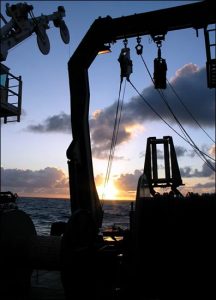Dispatch 11 – Catching rain in a hurricane

Happy to have brought the 7th of 7 NBSTs on board! from left to right- WHOI colleagues Steve Manganini, Devin Ruddick, Jim Valdes and Ken Buesseler.
A basic problem that VERTIGO sets out to study, is how fast do particles in the ocean sink from the surface where they are produced, to the deep ocean, and how many break apart or are consumed by animals and bacteria along the way. Part of the problem is that catching sinking particles in classic “sediment traps” is like putting out a rain gauge in a hurricane. Surface ocean currents carry particles a hundred times faster horizontally than they sink vertically. So a sediment trap collector, which is simply a tube or cone placed at a fixed depth to collect sinking particles, has a hard time measuring what is sinking since the faster ocean currents carry particles over, in and out of the sampling tubes.
A solution to this problem was developed by WHOI engineer Jim Valdes and Senior Scientist Jim Price, who attached the classic sediment trap collection tubes to the outside of a neutrally buoyant float that physical oceanographers use to study the direction and speed of ocean currents. Think of a hot air balloon being carried by the wind with a rain gauge attached, with the only controls being up or down, and that’s essentially what a Neutrally Buoyant Sediment Trap or NBST does in the ocean.
What is truly amazing about engineering these devices, and why it has taken so long for us to reach this point, is that the ballasting or weight of these devices has to be extremely well controlled. Each NBST weighs close to 100 pounds in air, and differences as small as 13 gm, or the weight of one medium washer, can send the whole package down another 100m or more than 300 feet. Imagine if you were swimming and having a few coins in your pocket meant the difference between sinking or swimming!
Well this simple idea has taken more than 7 years since conception till today, when last week during VERTIGO we launched 7 NBST’s on a mission to the “Twilight Zone” or those depths where the sunlight penetrates very weakly in the ocean (below the surface down to 500 meters or about 1,500 feet). The devices are preprogrammed to sink slowly to depth and then return to the surface after a few day mission, and then beam their position to a satellite and if close enough, our ship, so we can find them.
NBSTs are actually hard to see in the ocean in the daytime since they are so small, so we scheduled night pickups out of the water when we can more easily spot the tiny flasher that sits on the top of the NBSTs over distances of just over 2 miles. The crew of the R/V Kilo Moana are experts at sighting these small packages and maneuvering the vessel alongside for easy pickup by the scientists. This time, 7 NBSTs went in the water and all 7 came back with their precious cargo- a first in ocean sciences history!
Once back on board, each of the 5 collection tubes and their precious cargo are processed immediately on the ship. Some samples are examined under a microscope, others frozen or chemically preserved, and most filtered through one of 3 different filter types to allow for a wide range of chemical and biological analyses back in our home labs, but that’s another story.
— Ken Buesseler

Well after sunset or before sunrise is the best time to spot the flashers on the NBSTs for pickup and recovery using the winches and A frame on the fan tail of the R/V Kilo Moana to lift them on board. (Photo by Mark Gall)

Close up of washers used to ballast NBST. One of these weights can mean the difference between correctly ballasting to descend to the correct depth, or sinking out of control to the ocean floor. (Photo by Ken Buesseler).